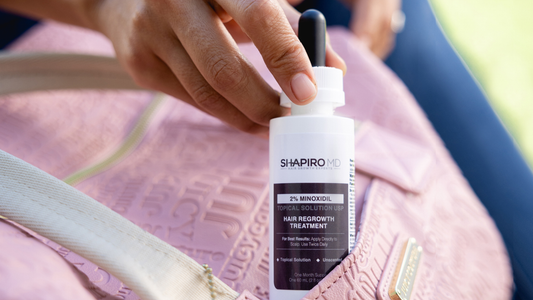If you’re experiencing hair loss, you may think your situation is unusual. However, female hair loss is not as uncommon as you might think. In fact, the American Hair Loss Association reports that 40% of Americans suffering from loss of hair are women. While baldness is embarrassing for men, it can be emotionally devastating for women, who often consider scalp hair a representation of beauty and femininity.
How Hair Loss Affects Women
It’s not as common for women with hair loss to get a bald spot on the top of the head or a receding hairline like men commonly experience. Instead, female-pattern hair loss generally causes a visible thinning of the hair over the crown. Most women first notice hair loss when their ponytail feels thinner or their part becomes noticeably wider. Wispy hairs often form in affected areas because the hair has a shortened growth cycle.
There are many different treatments available for hair loss, so it’s important to find the type that’s most effective for you. Some treatments are designed to be applied externally, while others come in the form of supplementation or oral medication. There’s also the option of surgical intervention if your hair doesn’t respond to less-invasive options. Once you’ve studied the following treatment choices, you’ll have an easier time deciding which option(s) to pursue.
Oral Medications
Oral medications are a less common treatment for female hair loss, though some doctors will take action when the hair thinning is very clearly caused by a hormone imbalance. Finasteride is the only oral medication approved by the FDA for the treatment of hair loss in the U.S., but its use is restricted to men only. That’s because it can have negative effects on women’s hormones; women who are pregnant are at risk of hurting their unborn fetus if they take finasteride during pregnancy, for example.
Most oral medications that get used off-label for female hair thinning still contain ingredients designed to affect hormones, namely DHT, also commonly referred to as “The Hair Loss Hormone” from attaching to androgen receptors on hair follicles. Here are a few medications that you may have heard of in relation to hair loss:
Spironolactone: Medication that contains spironolactone works by reducing the presence of male sex (androgen) hormones like testosterone and DHT in the female body, slowing down androgen production in the ovaries and adrenal glands. It has been shown to have some beneficial effects for women’s hair growth, but spironolactone isn’t approved by the FDA for this indication, and thus its use should be monitored and only at the direction of a licensed physician. If hair loss isn’t due to a hormone imbalance, spironolactone won’t help.
Cimetidine: Medication containing cimetidine has been successfully used to treat androgenic alopecia in women. Cimetidine is thought to work by blocking androgen action as well. It can cause feminizing effects, so it is not recommended for men. Like spironolactone, it’s not approved by the FDA for hair loss, and it should be taken only under the guidance and care of a trained physician.
Oral Contraceptives: Oral contraceptives are sometimes used to treat hormone-related hair loss in women because they decrease the production of male androgens. It’s important to know all the potential side effects and contraindications associated with birth control pills before taking them for thinning hair. It’s also important to note that only low-androgen index birth control pills are appropriate for hair loss treatment. High androgen index birth control pills may have the opposite effect and can actually contribute to hair loss.
As with any medication, it’s important to consult with your doctor about any side effects you experience while taking any of these oral prescriptions. Because the oral medications that see use among women are all only used off-label, a physician or dermatologist consultation is the best course of action before considering these ingredients.
Topical Treatments
Topical treatments are often recommended for hair thinning because they are less likely to cause internal side effects than oral medications. Common topical treatments for female hair thinning include:
Ketoconazole: This topical treatment is commonly used to treat fungal infections, but may also prevent or slow hair loss by curbing the production of androgens, including testosterone, by the reproductive organs and adrenal gland. Aggressive treatment of androgenic alopecia has been shown to contribute to the rapid growth of new hair.
Minoxidil: Minoxidil was originally given to patients with high blood pressure, but those who took it noticed that they started to regrow hair in places they had previously lost it. After this discovery, additional research was conducted and minoxidil’s effectiveness in stimulating hair regrowth was confirmed. Minoxidil was originally available in the United States under the brand name Rogaine®, but today you can find affordable alternative generics from providers like Shapiro MD.
Shampoos and ointments containing ingredients like vitamins and minerals are also helpful for hair growth and strength, and many do not require a prescription. Shapiro MD’s line of naturally derived Shampoo, Conditioner, Leave-in Foam, and Leave-in Conditioner were formulated to fight DHT at the scalp with only natural ingredients. These botanical extracts include ECGC, a derivative of green tea leaves, saw palmetto berry extract, and caffeine. Combined in these formulations, over 85% of women in a Shapiro MD survey reported seeing results within 6 months.
Surgical Treatments
In addition to oral and topical treatment options, surgical procedures are also available for rare types of female hair loss. Since female pattern baldness is generally characterized by an overall thinning of the hair, surgery is not an effective option for most women. However, for the small percentage (about 2% to 5%) of women who have a distinct pattern of baldness, surgical hair restoration may be a viable option.
Learn More
You don’t have to live with the sensitivity that comes with hair loss. For more information about products that can help prevent hair loss in women, Shapiro MD’s telemedicine platform helps men and women get prescription hair care solutions (if appropriate) from home, delivered to their door, and with the help of a licensed physician. Take our free hair care quiz to get started.




